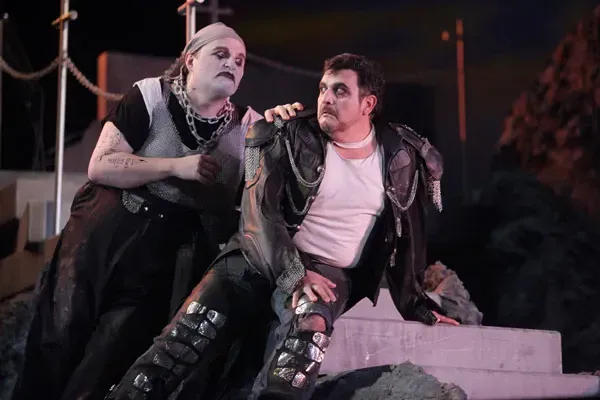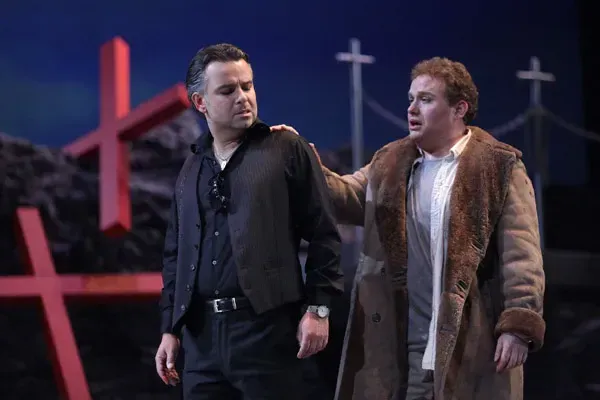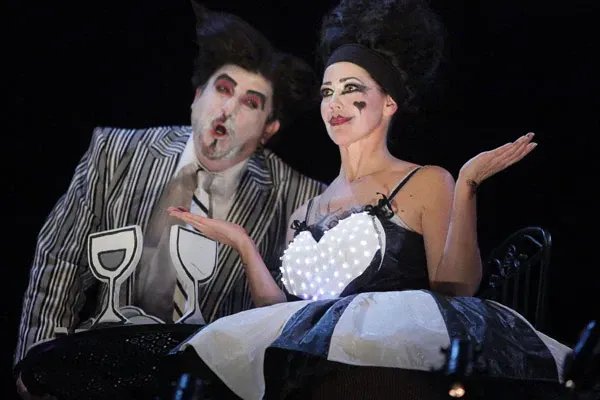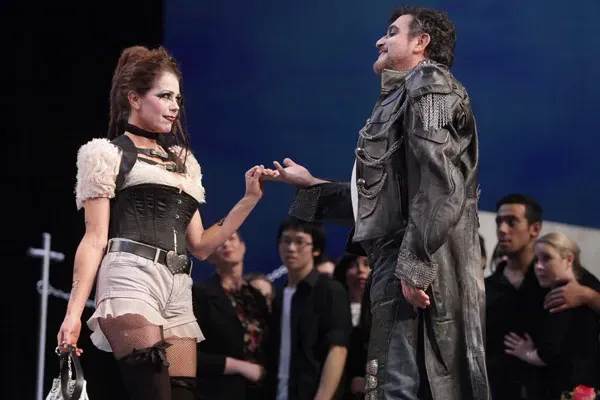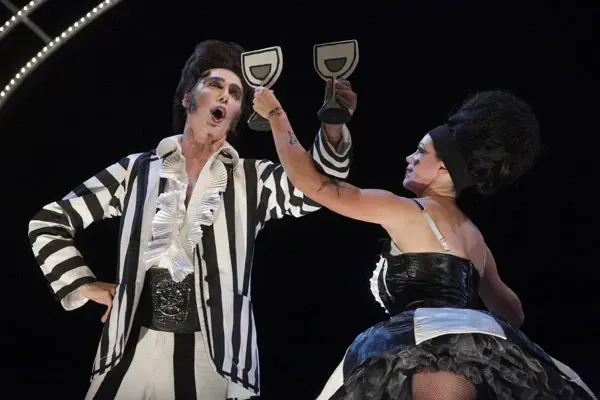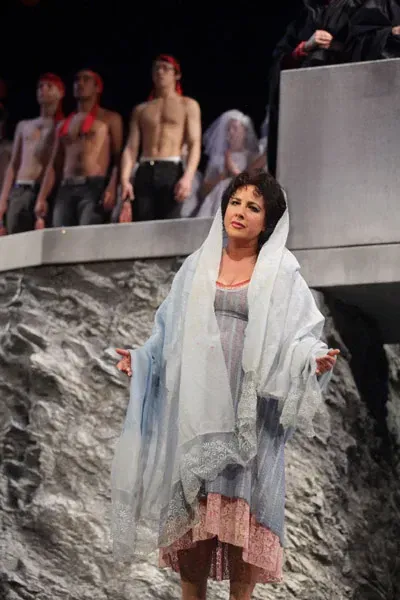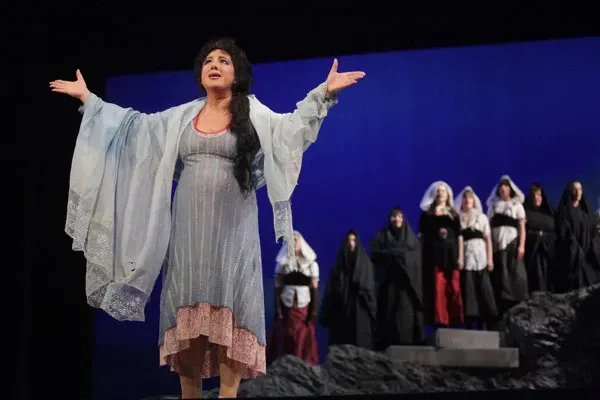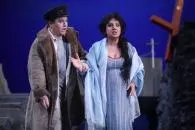Review: Cav & Pag
Written by
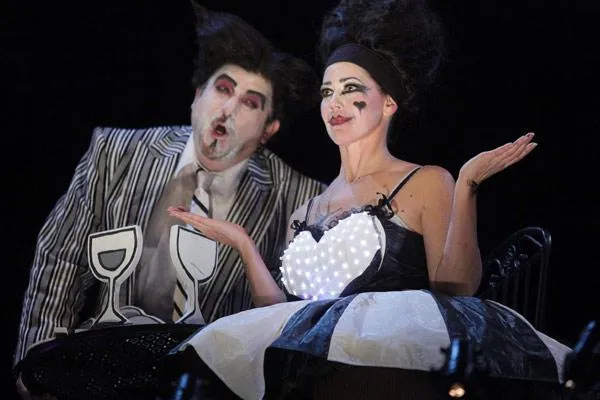
Reviewed by Richard Howard
Cavalleria Rusticana & Pagliacci, two of the finest operas of the genre, were the first great successes for their two respective composers and in fact their last and as such we the audience witness two rare, intense moments of genius.
There is no question that the NBR New Zealand Opera’s latest productions of Cavalleria Rusticana and Pagliacci played as the usual double bill, in Wellington with the superb Vector Wellington Orchestra, under the baton of Oliver Von Dohnanyi at the St James Theatre, are both musical and vocal triumphs for the company.
This is a must see show, even if you have to spend the grocery money; especially for those of you who have never been to the Opera these works offer an ideal, accessible and sweet introduction to the high musical art.
How luxuriant it was to sit back, to be aurally bathed in the sheer scale and beauty of the magnificent music, to be plunged into the depths of human dilemma and lifted into the heightened realms of human emotion. For these reasons (and for the possibility of rich spectacle) I love the opera and why I loved these productions – well mainly.
With Opera the plots are traditionally secondary to the opportunity for amazing music and singing and such is the case with these two works. Nevertheless each work portrayed with vivid and sometimes poignant truth the highlights, brutalities, tragedies and endurance of human endeavour and behaviour. For those of you looking for relevance from the Opera, there it is right there, all be it in a more palatable form than the harder reality of our streets and homes.
In both works we see the revelations and reactions to love, longing, obsession, infidelity, jealousy, revenge and loss – all very good fodder for drama and for us as individuals to ponder on in our own terms.
The rich, full-bodied Mezzo Soprano voice of the highly accomplished Anna Shafajinskaia (of the Ukraine) who played Santuzza in Cavalleria Rusticana, jilted, pregnant , excommunicated from the church, vocally claimed every corner of the theatre as she sings of her anguish for her lost lover and her fate.
Turiddu, played by the equally accomplished English Singer Peter Auty, a young Sicilian macho buck returning from the war has seduced Santuzza; and indeed vocally he seduced me as well with his full-chested, strong tenor charms.
The very beautiful, New Zealand lyric Soprano Anna Pierard was an excellent choice for the role of Lola, early lover of Turiddu, between whom the love has since rekindled even though Lola married Alfio while Turiddu was away. Anna brings a marvelous voice and a sensuous, slightly slutty, temptress quality to the action.
Wendy Doyle, Mamma Lucia another of New Zealand’s finest, ably brings a mother’s heart, the right kind of physicality and a rich vocal tone to the stage and the dilemma that unfolds. Likewise the beautiful baritone voice of Marcin Bronikowski (of Poland) the cuckolded husband of Lola completes the marvellous soundscape; even though failing to deliver a sense of true fury and vengeance in his voice or acting appropriate to the intent of plot.
The NBR NZ Opera has consistently developed from strength to strength under the leadership of Aidan Lang, Director of the NBR New Zealand Opera and his dedicated production team, proving a capacity to produce international quality work with highly accomplished New Zealand and international singers and musicians and with high production values; no mean feat on this small group of islands somewhere closer to the Antarctica than Europe.
I fully agree with him when in his brief after-show address to guests he high-lighted the significant musical and entrepreneurial achievement of the productions, reminding us that - “ we are not in Munich, we are in Wellington, New Zealand and to have music and singers of this calibre is remarkable”.
Between the two shows of a little over an hour each there are 10 principle performers, an onstage chorus of 50 or so, 18 in the children’s chorus and another substantial chorus of 44 working off stage. Oh, and then there is the orchestra of 63 players as well and the backstage crew. This is not so much a cast and crew as a small town population in Sicily (where the Operas are placed)! It is by any standard a magnificent and a rare turn out of highly-skilled people for a New Zealand stage all of whom were clearly committed whole-heartedly to produce and perform the works.
In fact this was the first time I have experienced either of the shows onstage and although I truly loved the music of Cavalleria Rusticana, Pagliacci was for me the more accomplished production and the more enjoyable experience simply because the story is more interesting and the acting supported the plot and the emotional heights of the music in a more accomplished way.
It is perhaps of interest for readers to briefly examine the dilemma of the Opera which is what I did frequently through the first part of the evening.
Opera more than any of the other high art forms requires the audience to substantially suspend their disbelief in order to sensually and emotionally mainline into the composers heart and soul laid bare within the work; but how far are contemporary audiences prepared or able to do so? How many incongruities and contrivances in casting, physicality, the acting, the setting, plot, place and style are we prepared to disregard for the rewards (and they truly are substantial rewards) of the astounding synergy of musical genius, orchestral and vocal brilliance?
Ideally, none would be my choice; being someone who is always willing to be carried off completely into the intricacies and images, illusion and emotion of a good story.
Singers are trained over many years to sing (gloriously) but seldom are they trained it would seem to deliver dramatized performance at the same professional level which creates for a discerning audience, incongruity between the ever-shifting emotional intent of the music and what we see in the delivery of the action and the plot.
This was the case in the first of these two productions (Cavalleria Rusticana); where clashes of competencies became evident, where world class singing was largely presented through cod acting and the essential promise of the theatre is not delivered, which is to make the audience totally believe!
Cavalleria is superbly sung and although less well structured than Pagliacci, it could well have had much greater dramatic and emotional impact if the singer /performers including the wonderful Chapman Tripp chorus could simply relax a little and focus on BEING their characters and interacting naturally with one another rather than having the tendency to play act.
This I suggest would be a worthy production challenge for future NBR New Zealand Opera company productions for both cast and chorus.
Fortunately in contrast, Pagliacci drew my attention immediately through the fine performance instincts and glorious bass baritone voice of Warwick Fyfe as Tonio - The Prologue. I believed he was the hurt, sad, lonely, love lost and vengeful character that he played out.
So, to with Elizabeth Futral (of the USA) whose fabulous singing and acting synthesized very satisfyingly into a high quality and interesting performance. Her fear of her abusive husband Canio, her contempt and distaste for her suitor Tonio was clear as was her fatalistic sense that she would never escape with her lover Silvio.
The slight less powerful but melodious voice, the quirky physicality and theatrical interpretation of New Zealand, tenor, Andrew Glover playing the roving actor Bebe, added hugely to the quality of the piece, clearly demonstrating the benefits of his early acting and his singing training. Andrew is by the way the Mina Foley Scholar of 2011.
So it was with this strong, skilled cast and within a significantly more interesting story that Canio himself, well played by Rafael Rojas from Mexico, delivered the aria of the evening with a tearful heat-breaking performance of love and loss in the arias of all arias, Vesti la guibba, with such vocal force and ardor that I swear it loosened a shower of plaster dust from the proscenium and all but achieved a standing ovation. It was thrilling.
All performers proved the point that accomplished acting and singing can be brought together very successfully at the Opera with the right choices and direction.
The funky contemporary approach to costume design although very well executed by Elisabeth Whiting and Co as usual simply didn’t work for me in either production. The feigned use of cell phones among the chorus worked even less (grrr).
In fact I remained very confused and distracted right through Cavalleria Rusticana with the mixture of jeans, suits, sunglasses, then traditional peasant costumes and religious robes and fur trimmed coats as to what era and season was actually being portrayed – what have I missed here?
In Pagliacci we are asked to believe that a 40- 50 year Canio is “cool” in leather gear and chains and that with tats, high cut off jeans, and in Goth makeup and accessories Nedda is going to be attracted and hot for her lover Silvio who wears a very conservative Hallestein’s styled, light coloured suit. Hmmm, I don’t think so.
Here the attempt at verismo (realism in opera) seem misplaced in the design approach and imposing, even distorting the characters as they need to be played to communicate to the audience..
I get that Opera and theatre companies around the planet want to inject a sense of contemporary relevance into classic works but I wonder if this is really the most interesting and valid way – the approach simply did not add value to the experience of these otherwise fine productions.
Contemporising the acting /performance style would to my mind be the more rewarding endeavour.
Referencing to my earlier question; I say that we can forgive almost all at the opera except less than brilliant singing and those aspects of the overall performance that are distracting from the emotional intention of the music and the successful fulfilment of the plot.
John Parkers set was ingenious and a credit to his construction and creative team - an outcrop of (very real looking) rock on a Sicilian Island with a suggestion that the pathway cut into the huge boulders lead to an elevated village chapel offstage.
The set and presumably the same village were used in both productions as were the chorus as the villagers. In Pagliacci a surprising addition to the set provides a magical space among the rocks in which the play within the play is performed by the travelling actors to great and amusing effect.
More subtle lighting (and less bright) in Cavalleria Rusticana would have added depth and even greater realism to the set and blended both the visual illusion and the action into a more compelling picture with atmosphere; as was achieved in Pagliacci when the day turned to an evening vista – this latter scene being a moment of staged opera magic.
I noted a on a number of occasions through the two shows that the vocal intensity of the lead singers altered significantly according to where they were on the stage at the St James. The acoustic quality weakened the higher on the set the singers were positioned and of course if the action required them to sing towards the back of the stage. Should this be accepted as just a natural consequence of live performance and physical circumstance or exposure to perfectly produced recordings or can it and should it be sorted out?
When Opera’s are sung in languages other than the native language of the country in which they are performed (Italian in this case) the need for subtitles and where to place the screens always arises. It is difficult to please everyone and in fact anyone in some halls – to high, too low, too distracting. In these productions for me sitting on the side of the stalls the screens were too high and too much to the side to maintain a comfortable attention to both the action and the wording.
Actually I think I would like to see the art of the written libretto acknowledged fully along with the art of the music and performance and therefore for subtitles to be incorporated into the visual presentation on stage proper above the action – but that may not be a popular opinion and I recognise the technical challenge.
Few Opera productions are without flaws and incongruities and still they can be regarded as great works. It is up to the audience and the readers of this review to give weight to what is important and not important to them in the experience of these marvellous shows. For myself I had a hugely enjoyable evening and valued so much about the works but I also still want more from NBR New Zealand Opera Company, to sky rocket me further into Opera heaven.
